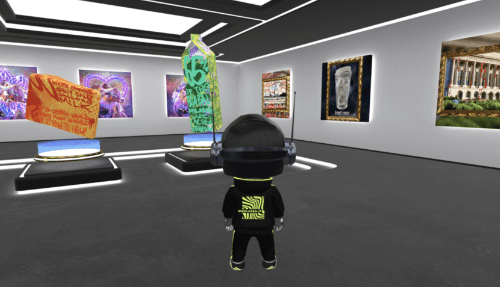Store Nfts Nftespoacute9to5mac

The emergence of Non-Fungible Tokens (NFTs) has revolutionized the digital art market, offering a unique way to authenticate and trade digital assets.
One platform that has gained significant attention in this space is Store NFT, powered by Nftespoácio9to5mac.
This article explores the rise of NFTs in the digital art market, provides insights into buying and selling NFTs on Store NFT platforms, discusses the future prospects of Store NFTs and their impact on artists, collectors, and investors.
In recent years, there has been an increasing demand for digital artworks as people seek new ways to express themselves and own unique pieces of art.
The introduction of NFTs has provided a solution to the long-standing issue of provenance and ownership in the digital realm.
Store NFT, with its collaboration with nftespoácio9to5mac, offers a secure platform for artists to tokenize their works and sell them directly to collectors without intermediaries.
Understanding how to navigate the world of buying and selling NFTs is crucial for both artists looking to monetize their creations and collectors seeking valuable digital assets.
This article will delve into the process of acquiring and trading NFTs on Store NFT platforms while also exploring the potential risks and rewards associated with this emerging market.
Additionally, it will examine how Store NFTs can potentially reshape traditional notions of art ownership by providing greater accessibility and inclusivity in an industry that has often been exclusive.
By analyzing these developments objectively, we can gain a deeper understanding of the implications store nfts nftespoácio9to5mac have on artistic freedom within the digital asset market.
The Rise of NFTs in the Digital Art Market
The increasing prominence of NFTs in the digital art market has been evident, signaling a notable shift in the perception and value attributed to these unique digital assets.
The tokenization of art through blockchain technology has provided artists with new opportunities for monetization and ownership verification, revolutionizing the art market.
By creating a digital representation of their work as an NFT, artists can establish scarcity and provenance, enhancing the value and authenticity of their creations.
Additionally, blockchain technology ensures transparent transactions and eliminates the need for intermediaries, allowing artists to directly sell their works to collectors without traditional barriers.
This decentralization of the art market empowers both artists and collectors by democratizing access to artwork while preserving its uniqueness.
As a result, NFTs have captured the attention of not only established artists but also emerging talents seeking innovative ways to showcase their creativity.
The incorporation of blockchain technology into the digital art industry has opened up new possibilities for artistic expression while challenging traditional notions of ownership and value in art.
How to Buy and Sell NFTs on Store NFT Platforms
To engage in the buying and selling of Non-Fungible Tokens (NFTs) on various online platforms, individuals can follow a straightforward process.
First, they need to explore NFT marketplaces where they can find the best deals and rare collectibles. These platforms, such as OpenSea, Rarible, and SuperRare, provide a wide range of NFTs from digital art to virtual real estate.
Second, it is crucial to understand the underlying technology behind store NFT platforms – blockchain. Blockchain technology ensures the security and authenticity of NFT transactions by recording them on a decentralized ledger. By familiarizing themselves with this technology, individuals can make informed decisions when buying or selling NFTs.
Third, interested buyers should create an account on their chosen platform and set up a digital wallet that supports the specific blockchain network used by that platform. This wallet will serve as their digital identity for transactions within the marketplace.
Lastly, once individuals have completed these steps, they can start browsing through available NFTs for sale or list their own creations for others to buy. The process may vary slightly depending on the platform but generally follows these steps: search for desired NFTs based on categories or keywords, review information about each item including its creator and price, place bids or purchase directly using cryptocurrency like Ethereum (ETH), and transfer ownership into their digital wallet upon successful transaction completion.
With these simple steps in mind, individuals can participate in the exciting world of buying and selling NFTs on store NFT platforms while embracing the freedom offered by this booming industry.
The Future of Store NFTs and the Digital Asset Market
Predictions regarding the future trajectory of digital asset markets indicate a significant potential for growth and innovation, as emerging technologies continue to disrupt traditional economic paradigms.
As the digital asset market evolves, one key trend that is expected to shape its future is the tokenization of physical assets. Tokenization refers to the process of representing real-world assets as digital tokens on a blockchain, enabling fractional ownership and increased liquidity. This has the potential to unlock new investment opportunities and democratize access to traditionally illiquid assets such as real estate or artwork.
Blockchain technology plays a crucial role in facilitating this transformation by providing transparency, security, and immutability to these digital representations of physical assets. By leveraging blockchain’s decentralized nature, individuals can trade and transfer ownership of these tokens without relying on intermediaries, reducing costs and increasing efficiency in the market.
Furthermore, blockchain-based smart contracts enable programmable ownership rights and revenue-sharing models, creating innovative ways for creators and investors to monetize their assets.
With ongoing advancements in blockchain technology and increased adoption of tokenization practices across industries, it is likely that store NFTs will continue to gain traction as an integral part of the evolving digital asset market.
The Impact of Store NFTs on Artists, Collectors, and Investors
Symbolizing the transformative power of store NFTs, artists, collectors, and investors are experiencing unprecedented opportunities for value creation and financial growth.
The impact on copyright is significant as it allows artists to assert their ownership over digital creations through unique tokens, thereby addressing the issue of unauthorized reproduction and distribution.
Additionally, this technology provides a transparent and immutable record of ownership, ensuring that artists receive appropriate credit and compensation for their work.
However, these advancements also pose challenges for the traditional art market. As more creators turn to digital platforms to sell their NFTs directly to consumers, galleries and auction houses may face a decline in their role as intermediaries.
Moreover, the potential for mass production of digital art raises questions about scarcity and exclusivity that have long been central to the art market’s value system.
Despite these challenges, store NFTs offer an exciting avenue for artists to reach a global audience while empowering collectors and investors with new ways to engage with and support artistic expression.
See also Expressvpn The Economictimes
Frequently Asked Questions
Are NFTs only applicable to digital art or can they be used for other types of assets?
NFTs are not limited to digital art; they have the potential to revolutionize real estate transactions by enabling seamless buying and selling of properties. Additionally, NFTs can disrupt the traditional collectibles market by transforming the way valuable items are bought and sold.
What is the role of blockchain technology in the creation and ownership of NFTs?
Blockchain technology plays a pivotal role in the creation and ownership of NFTs, revolutionizing the art market. Its decentralized nature ensures transparency, immutability, and security, empowering artists and collectors while challenging traditional gatekeepers.
How do NFT creators and artists receive royalties or ongoing revenue from the resale of their digital assets?
Royalty distribution models for NFT creators ensure ongoing revenue from the resale of their digital assets. Secondary market sales have a direct impact on NFT artists’ revenue, allowing them to benefit from increased demand and value in the market.
Are there any legal considerations or regulations surrounding the ownership and trade of NFTs?
Legal implications and tax implications are important considerations in the ownership and trade of NFTs. Regulations regarding intellectual property rights, securities laws, and tax obligations vary by jurisdiction and should be carefully evaluated by individuals engaging in NFT transactions.
Can NFTs be purchased and stored offline, or do they always require an internet connection?
NFTs can be purchased and stored offline, eliminating the need for a constant internet connection. Offline storage options include hardware wallets or physical copies of the NFT file. This offers flexibility and security to users who value independence and freedom in managing their digital assets.
Conclusion
In conclusion, the rise of NFTs in the digital art market has revolutionized the way we perceive and trade artwork. These unique digital assets have provided artists with a new platform to showcase their creativity and reach a global audience. With store NFT platforms, buying and selling NFTs has become more accessible than ever before.
The future of store NFTs holds immense potential for both artists and collectors. As technology continues to advance, these digital assets will only grow in value and significance. The impact of store NFTs on artists cannot be understated – it has allowed them to break free from traditional art markets and find success in the digital realm. Likewise, collectors now have an opportunity to own one-of-a-kind pieces that can be easily traded or displayed digitally.
Investors too have recognized the value of store NFTs as an alternative asset class. With their scarcity and uniqueness, these digital art pieces offer a level of exclusivity that is highly sought after. As store NFT platforms continue to evolve and innovate, we can expect even greater opportunities for artists, collectors, and investors alike.
In this new era of digital art ownership, emotions run high as individuals connect with artworks on a personal level without limitations imposed by physicality. The intangible nature of these virtual assets allows for boundless creativity where imagination takes flight through pixels on screens. From vibrant abstract compositions to thought-provoking conceptual pieces, store NFTs offer an immersive experience that transcends boundaries, capturing our hearts while expanding our minds.
As you delve into the world of store NFTs, prepare yourself for an emotional journey that challenges conventional perceptions about art ownership. Witness how technology intertwines with artistic expression as each stroke or pixel comes alive within your screen’s confines. Embrace the evolution of creativity itself as traditional canvases make way for infinite possibilities in this ever-expanding landscape of digital artistry.




